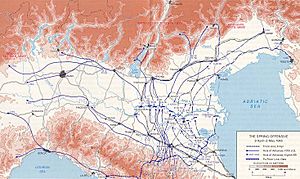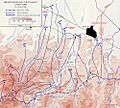Spring 1945 offensive in Italy facts for kids
Quick facts for kids Spring 1945 Offensive |
|||||||
|---|---|---|---|---|---|---|---|
| Part of the Italian Campaign of World War II | |||||||
 British troops pick their way through the ruins of Argenta, 18 April 1945 |
|||||||
|
|||||||
| Belligerents | |||||||
and others |
|||||||
| Commanders and leaders | |||||||
| Strength | |||||||
| 15th Army Group British 8th Army 632,980 fighting strength U.S. 5th Army 266,883 fighting strength |
Army Group C 394,000 fighting strength | ||||||
| Casualties and losses | |||||||
| 16,258 casualties incl. 2.860 killed |
30–32,000 casualties | ||||||
The Spring 1945 offensive in Italy was given the code name Operation Grapeshot. It was the Allied attack by Fifth United States Army and British 8th Army into the Lombardy Plain. It started on 6 April 1945 and ended on 2 May with the surrender of German forces in Italy.
Contents
Background
The Allies had done their previous major attack on the Gothic Line in August 1944. The British 8th Army attacked up the coast of the Adriatic Sea. The U.S. 5th Army attacked through the central Apennine Mountains.
They managed to break through the Gothic Line defences. But they failed to get into the Lombardy Plains before the winter weather stopped them. They had a hard time in the cold winter weather. They planned to attack again in the spring.
Command changes
Harold Alexander was promoted to Field Marshal. He was made the Allied Supreme Commander Mediterranean on 12 December.
On 23 March, Albert Kesselring was appointed Commander-in-Chief Army Group West.
Orders of battle
In the spring, the problems of getting troops continued. The 15th Army Group had 1,334,000 men with Eighth Army having 632,980 men and Fifth Army 266,883. Against them were 21 much weaker German divisions and 4 Italian divisions, a total of 25.
Plan of attack
Clark made his plan on 18 March. He wanted destroy the maximum number of enemy forces, cross the Po and capture Verona.
The Eighth Army was to go north west to capture Ferrara and Bondeno. The U.S. Fifth Army was to go past Bologna to surround German forces south of the Po. The Fifth Army was to go west towards Ostiglia. Next, the Allies would capture bridge across the Po and go north.
The Fifth Army plan (Operation Craftsman) aimed to pull German reserves away from Route 65. II Corps would then attack.
Battle
In the first week of April, attacks were launched on the right and left of the Allied lines. The goal was to draw German reserves away from the main attacks to come. Axis forces had to use sea, canal and river routes for supply. Axis shipping was being attacked in bombing raids.
The main attack started on 6 April with an artillery bombing of the Senio defenses. On 9 April, 825 heavy bombers dropped bombs near the Senio. From 15:20 to 19:10, artillery was fired. As well, 28 Churchill Crocodiles and 127 Wasp flamethrower vehicles were sent out. By 12 April, the 8th Indian Division was on the far side of the Santerno. The British 78th Division moved to attack Argenta.
The U.S. 5th Army began its attack on 14 April. First, there was a bombing by 2,000 heavy bombers and 2,000 artillery pieces. Then troops attacked. By 20 April both corps had broken through the German defences and reached the Po valley. 10th Mountain Division went north. By 19 April, the British 6th Armoured Division was moving to surround the German armies defending Bologna. Bondeno was captured on 23 April. Bologna was entered on 21 April. U.S. IV Corps reached the river Po at on 22 April. They went north to Verona which they entered on 26 April. British V Corps entered Padua on 29 April. Partisans had captured the German garrison of 5,000.
Afterwards
Secret surrender talks between the Germans and Western Allies were held in Switzerland (Operation Crossword) in March. The Soviets did not like that the Western Allies were trying to arrange a surrender that did not include the Soviets. On 29 April, the Germans surrendered.
Images for kids
-
Men of the Jewish Brigade ride on a Churchill tank in the Mezzano-Alfonsine sector, 14 March 1945.
-
Brazilian infantry resting beside a US M10 tank destroyer, April 1945





